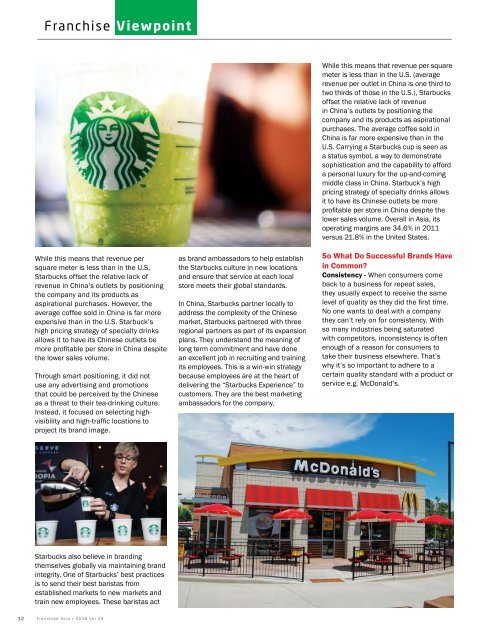FRANCHISE ASIA JAN 2016
You also want an ePaper? Increase the reach of your titles
YUMPU automatically turns print PDFs into web optimized ePapers that Google loves.
Franchise Viewpoint<br />
While this means that revenue per<br />
square meter is less than in the U.S,<br />
Starbucks offset the relative lack of<br />
revenue in China’s outlets by positioning<br />
the company and its products as<br />
aspirational purchases. However, the<br />
average coffee sold in China is far more<br />
expensive than in the U.S. Starbuck’s<br />
high pricing strategy of specialty drinks<br />
allows it to have its Chinese outlets be<br />
more profitable per store in China despite<br />
the lower sales volume.<br />
Through smart positioning, it did not<br />
use any advertising and promotions<br />
that could be perceived by the Chinese<br />
as a threat to their tea-drinking culture.<br />
Instead, it focused on selecting highvisibility<br />
and high-traffic locations to<br />
project its brand image.<br />
as brand ambassadors to help establish<br />
the Starbucks culture in new locations<br />
and ensure that service at each local<br />
store meets their global standards.<br />
In China, Starbucks partner locally to<br />
address the complexity of the Chinese<br />
market, Starbucks partnered with three<br />
regional partners as part of its expansion<br />
plans. They understand the meaning of<br />
long term commitment and have done<br />
an excellent job in recruiting and training<br />
its employees. This is a win-win strategy<br />
because employees are at the heart of<br />
delivering the “Starbucks Experience” to<br />
customers. They are the best marketing<br />
ambassadors for the company.<br />
While this means that revenue per square<br />
meter is less than in the U.S. (average<br />
revenue per outlet in China is one third to<br />
two thirds of those in the U.S.), Starbucks<br />
offset the relative lack of revenue<br />
in China’s outlets by positioning the<br />
company and its products as aspirational<br />
purchases. The average coffee sold in<br />
China is far more expensive than in the<br />
U.S. Carrying a Starbucks cup is seen as<br />
a status symbol, a way to demonstrate<br />
sophistication and the capability to afford<br />
a personal luxury for the up-and-coming<br />
middle class in China. Starbuck’s high<br />
pricing strategy of specialty drinks allows<br />
it to have its Chinese outlets be more<br />
profitable per store in China despite the<br />
lower sales volume. Overall in Asia, its<br />
operating margins are 34.6% in 2011<br />
versus 21.8% in the United States.<br />
So What Do Successful Brands Have<br />
in Common?<br />
Consistency - When consumers come<br />
back to a business for repeat sales,<br />
they usually expect to receive the same<br />
level of quality as they did the first time.<br />
No one wants to deal with a company<br />
they can’t rely on for consistency. With<br />
so many industries being saturated<br />
with competitors, inconsistency is often<br />
enough of a reason for consumers to<br />
take their business elsewhere. That’s<br />
why it’s so important to adhere to a<br />
certain quality standard with a product or<br />
service e.g. McDonald’s.<br />
Starbucks also believe in branding<br />
themselves globally via maintaining brand<br />
integrity. One of Starbucks’ best practices<br />
is to send their best baristas from<br />
established markets to new markets and<br />
train new employees. These baristas act<br />
12 Franchise Asia • <strong>2016</strong> Vol 29

















